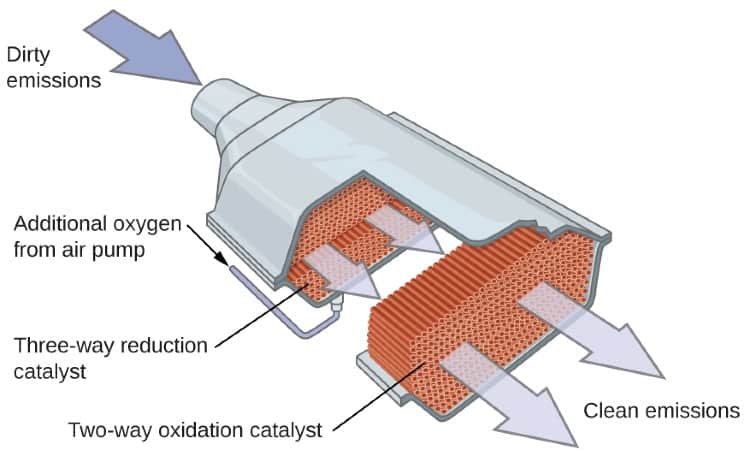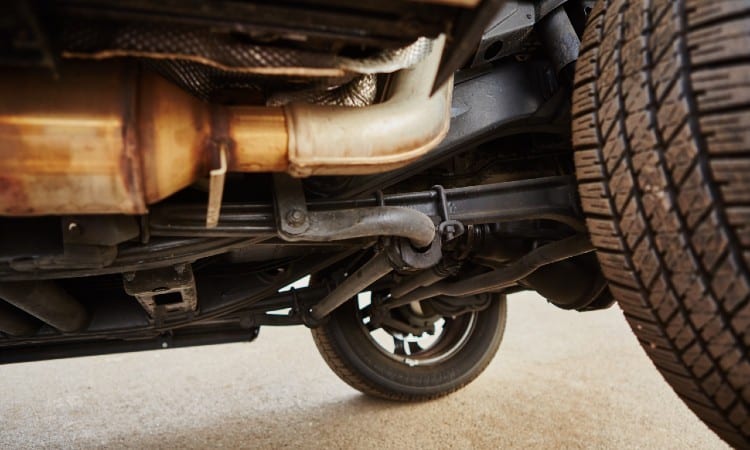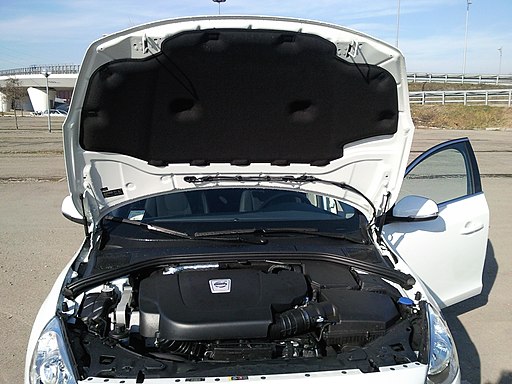After many thousands of miles, a catalytic converter will come to the end of its lifespan. When it does, you can experience a myriad of symptoms, including loss of performance, your check engine light coming on, and annoying rattling noises coming from underneath your vehicle. Since it can be an expensive part to replace, you may be trying to figure out ways to quiet a rattling catalytic converter until you can manage to get it to a mechanic.
In this article, we’re going to discuss different methods of how to stop catalytic converter rattling noise. All of these techniques can be performed at home with a basic set of tools for a minimal cost. Before we dig into them, we’re going to go over the symptoms of your catalytic converter failing.
Once you determine that yours is going bad, our six ways to quiet it will help you squeeze a bit more life out of it until you find the time or funds to take it to the mechanic’s shop.
For more information on a quieting your exhaust system, please see our article How to Quiet a Loud Exhaust.
What is a Catalytic Converter?
Because engines create power through an internal fuel combustion process, they release many pollutants into the air through the exhaust. These can include carbon monoxide, nitrogen oxides, and hydrocarbons, all of which are bad for the environment.
The catalytic converter is a device that is part of your exhaust system. It uses catalysts such as platinum to create a chemical reaction that nullifies these harmful pollutants. Often called just a cat, the catalytic converter is made of three main parts.

The Heat Shield – Surrounds the cat to prevent the high temperatures from escaping and causing potentially harmful consequences.
The Shell or Casing – The shell is the main body of the cat and it houses the internal components that perform the chemical reactions.
The High Flow Honeycomb Catalyst – Inside the catalytic converter, a honeycomb web of pathways allows the exhaust to make its way through. The walls of these paths are lined with the catalysts that create the chemical reactions that reduce harmful pollutants.
How Does a Catalytic Converter Work?
When exhaust enters into the catalytic converter, it passes through the inner honeycomb. Here it will come into contact with catalysts that will ignite the chemical reaction needed to convert the harmful pollutants. Two main types of catalysts will control this reaction; oxidation catalysts and reduction catalysts.

To nullify carbon monoxide and hydrocarbons, the oxidation catalysts will convert them to simple carbon dioxide and water. Similarly, the reduction of catalysts will break the nitrogen oxide down into oxygen and nitrogen.
The reason that two different types of catalysts are necessary is because carbon monoxide and hydrocarbons require a lean fuel/air mixture to be properly converted. Meanwhile, nitrogen oxide requires a rich fuel/air mixture.
Older style catalytic converters would first remove the nitrogen oxide from a rich fuel mixture. Then, air would be introduced, which would lean out the mixture making it possible to break down the carbon dioxide and hydrocarbons.
What Kind of Noise Does a Bad Catalytic Converter Can Make?
The catalysts inside the converter will continue to function almost indefinitely. However, physical wear on the exterior as well as damage inside caused by a buildup of oil or engine misfires can cause the catalytic converter to fail. When this happens, you may be able to hear the results.
Rattling Sound
If you hear a rattling noise that sounds like it’s coming from under your vehicle, it’s very likely coming from your catalytic converter. It may even sound like it’s coming from the engine. There’s a higher chance of hearing catalytic converter rattle noise when cold. Once the cat reaches temperature, you may not hear it anymore.
Ticking or Knocking Noise
If you’re hearing a ticking or knocking noise from catalytic converter, it could be caused by one of several issues. Some vehicles do make this type of sound at idle and it may not be something to be alarmed about. However, it’s also possible that it’s due to an exhaust leak, in which case, you’ll hear more catalytic converter noise when accelerating.
What Causes a Catalytic Converter to Rattle
When you hear your catalytic converter rattling, it may be on its last leg. But what is causing it to rattle?
Loose Heat Shield
Catalytic converter heat shield rattle is a pretty common occurrence that is caused by the heat shield becoming loose. Often, one or more of the bolts that hold it in place has broken, loosened, or become overly corroded. This allows the heat shield room to move around, causing it to rattle.
It’s possible to remove the heat shield, but this could cause excessive heat to transfer to the cab of your vehicle. It could also become a potential fire hazard if you drive over dry leaves or grass.
Ceramic Honeycomb Structure Breaks Apart
If you hear the rattle during acceleration, it’s likely that the ceramic honeycomb inside of your catalytic converter is broken. This can be caused by normal wear over time, or it can be from physical damage such as a direct impact on the catalytic converter.
The honeycomb itself may not be fixable, but there is a simple solution. Tap on the converter with a hammer until you can determine where the rattling is coming from. Then, insert a screw into the converter at that spot.
It will penetrate the honeycomb and hold it in place, hopefully, temporarily solving your rattling problem. This isn’t a permanent solution, but it can help you squeeze more miles out of your current cat.
6 Symptoms of a Bad Catalytic Converter
When your catalytic converter starts to go bad, it will begin to show symptoms that can alert you of the impending failure. If you pay attention to these signs, you’ll be able to get a jump on the issue.
1. Engine Begins to Perform Poorly
One of the most telling signs of a failing or clogged catalytic converter is decreased performance. This may come in the form of poor acceleration, a rough idle, or even a vehicle that won’t start. If the converter becomes clogged, the exhaust cannot flow freely through it. Likewise, if your converter is cracked, it can result in an exhaust leak with similar results.
2. Rattling Noise Coming From the Exhaust System
As explained above, rattling from your catalytic converter is a telltale sign that something isn’t right. It may be the external heat shield or even broken honeycomb inside.
3. Check Engine Warning Light Comes On
Thankfully, vehicles today have warning systems in place to alert you when something is wrong. The check engine light will illuminate if it senses a problem with your catalytic converter.
You can use an OBD2 reader to check the codes. If you don’t have one, your local auto parts store will check them for you. The code will tell you exactly what problem is being detected.
4. Smell Like Rotten Eggs
If you ever detect a sulfuric smell like rotten eggs being emitted from your exhaust, then a bad cat is a very likely culprit. Dark-colored smoke being expelled from the tailpipe is also another indicator.
5. Reduced Gas Mileage
Along with reduced performance, worsening gas mileage is an indication of inefficiency in the system that’s likely caused by a converter that’s either clogged or going bad.
6. Failed Emissions Test
Since it removes the pollutants from your exhaust, a catalytic converter is an essential component of passing an emissions test. If yours isn’t functioning properly, it will likely cause your vehicle to fail. Luckily, they will inform you of exactly what the problem is, so if it’s your cat, you’ll know before you leave the emissions station.
How to Quiet a Rattling Catalytic Converter

Now that we’ve discussed the possible causes of rattling in catalytic converter, it’s time to talk about some solutions. The following methods will help you rejuvenate an old cat and possibly save you $1,000 or more on replacing it.
1. Cleaning Your Catalytic Converter
One of the easiest methods of quieting and restoring a catalytic converter is to clean it. Over time, buildup in the cat can cause a blockage of airflow, resulting in unwanted noise and poor performance. These methods of cleaning will allow you to breathe new life into your old converter without spending a fortune replacing it.
2. With Sodium Hydroxide
To clean the catalytic converter with sodium hydroxide, you’ll first need to remove it from the vehicle. Then, soak the inside of the converter using a spray bottle. Make sure to spray into the cat from both sides.
Let the cat sit for 20 minutes or longer so the chemicals have time to work. After letting the chemicals work their magic, you’ll need to rinse it out properly. You can use a hose for this, but be sure to be very thorough. Again, make sure to rinse from both sides.
3. Using Lacquer Thinner
Lacquer thinner can be an effective tool for cleaning out an old cat or one that’s just losing efficiency. It’s also an easy method to employ. You’ll want to add one gallon of pure lacquer thinner to your gas tank with about 10 gallons of gas.
Drive the vehicle for about 150 miles, trying to keep the RPMs around 2500 or higher for at least 30 minutes. Once the lacquer thinner has worked through the system, you should experience improved performance, and hopefully, the rattling is gone as well.
4. Using High Octane Fuel and Fuel Additives
It may seem too simple, but sometimes all it takes to clean out your converter is to run higher quality gas through your system. If you usually use the lowest octane gas available, try running a few tanks of high-octane gas through your vehicle.
It may be enough to increase airflow and stop rattling noises. Similarly, certain additives can be purchased that will help clean out your cat when they’re added to your gas tank.
5. Fix Catalytic Converter Heat Shield
If the heat shield is missing bolts or has become loose, it can cause excess noise while the car runs. To fix this, you’ll first need to remove the heat shield. This can be done by removing a few bolts. You may need to use some penetrating oil since the high heat can cause the bolts to be quite stubborn.
Once removed, thoroughly wash the cat with soap and water. If the inside is hazy, you can polish it with some high-grit sandpaper to ensure maximum heat reflection.
Before reinstalling the heat shield, add some anti-seize compound on the bolts. Make sure to tighten them to the proper torque specifications.
6. Replace a Catalytic Converter
The exorbitant cost of replacing a catalytic converter can cause many people to wonder if it’s something they can replace themselves. Luckily, it’s not that complicated of a fix.
That said, make sure to purchase a direct fit converter that’s meant specifically for your vehicle, not a universal fit. A universal cat will require welding, while a vehicle-specific converter will be installed with bolts.
The first step is to douse the bolts with penetrating oil so they can be removed. Let it soak in for a while, then use a socket wrench to remove all four bolts.
Installing the new cat is just as simple. Set it in place and insert all four bolts, making sure to add some anti-seize compound to each of them first. Wrench the bolts down to the proper torque specification.
Though it’s a relatively simple operation, replacing the catalytic converter yourself can potentially save you a small fortune overtaking the car to a mechanic’s shop.
How Long Does a Catalytic Converter Last?
The catalysts in your converter could theoretically last forever since they are not consumed in the chemical reaction. Other factors can cause a cat to lose functionality or fail, though. A fuel mixture that’s too lean can easily cause it to clog.
Likewise, a misfiring cylinder can cause the converter to overheat and drastically shorten its lifespan. Short of these occurrences, your catalytic converter should continue to function without any issues.
Catalytic Converter Replacement Cost
Your vehicle must have a catalytic converter to pass emissions, so if it goes bad, you don’t have much choice to replace it. Unfortunately, it’s not a cheap part to replace. If you take it to a shop, you can expect to pay anywhere from about $600 to $2,000.
There are some ways to reduce this cost. The parts are a majority of the total price, but you can get a cheaper model by purchasing an aftermarket brand instead of an OEM device.
Also, you could save even more by installing the new cat yourself. It’s not a difficult replacement and if you’re proficient with tools it shouldn’t be a big deal. I’ve briefly explained the installation process above for your convenience. Since the labor for replacement can be as much as $100-200, you’ll be potentially saving yourself quite a bit of cash.
How to Minimize Problems with Your Catalytic Converter
Since it’s so expensive, most people would probably prefer to avoid replacing their catalytic converter. By following a few easy steps, you can prolong the life of yours, saving you trouble and headache in the long run.
Switching to high-octane fuel is the first step. This can help clean out your whole system, including your catalytic converter. By using high-octane gas all the time, you’ll prevent buildup in your cat that can cause problems down the road.
Also, be sure to take your vehicle for regular maintenance. Engine tune-ups and inspections performed at regular intervals can alert you to any developing problems before they grow into something larger. If your check engine light comes on, be sure to get it to a mechanic right away to avoid costly damage.
Finally, don’t let your car sit inactive for long periods. Your vehicle needs to be driven until it reaches operating temperature. This will require driving for about 20 minutes at highway speeds. I suggest doing this at least once a week.
Conclusion
Essential and expensive, a catalytic converter is one part on your vehicle you’d probably rather not replace. If it’s rattling or knocking though, it may be time for a new one. At the very least, you’ll need to try to clean it out and restore performance.
If you found this article to be an aid in your catalytic converter research, please feel free to share it so that others can find it more easily as well. If you have any questions or comments, please leave them in the comment box below so that I can respond in kind.
Image courtesy:
“Catalytic Converter” (CC BY 4.0) by OpenStax
You May Also Like:





2000 Pontiac Montana cat is making a noise I thought was an exhaust leak. Also sounds like a squealing belt. Found defective fuel pressure regulator due to external leakage, now I wonder how long it’s been rich. MIL comes on at high rpm with high throttle. Shows O2 sensors 1 & 2 low voltage. I climbed under and had wife start the car. It’s loud at first then quiets down. Opening throttle creates noise. MIL will not set code under normal low rpm medium load driving. Think I can try chemical cleaning?
A mechanic is saying he can temp fix by welding for about $60. I don’t know what he would weld, do you?
Thank you for this information I appreciate it and in Return I want to share with you the good news of the gospel of Jesus christ, thebridgeradio.Org
Hear the true gospel message like never before, listen learn and believe 🙏🏽